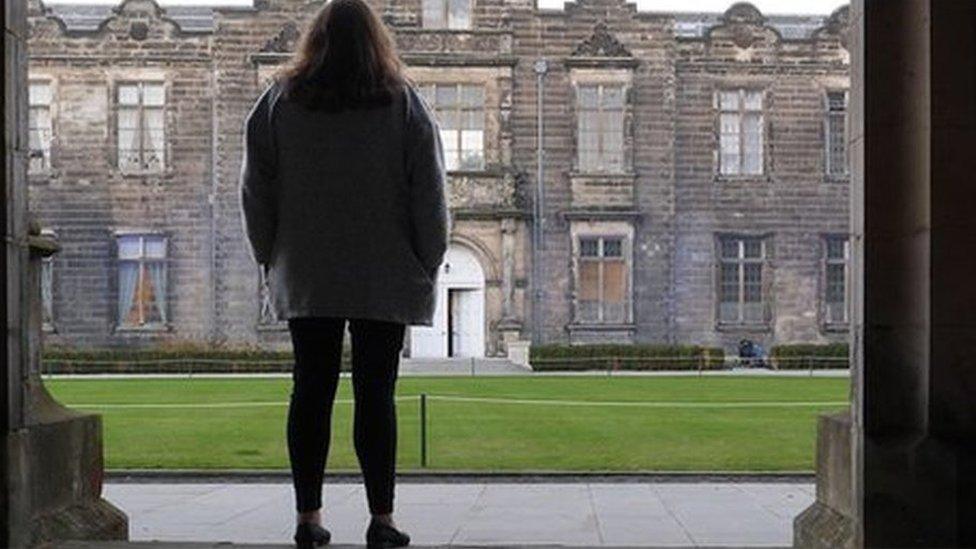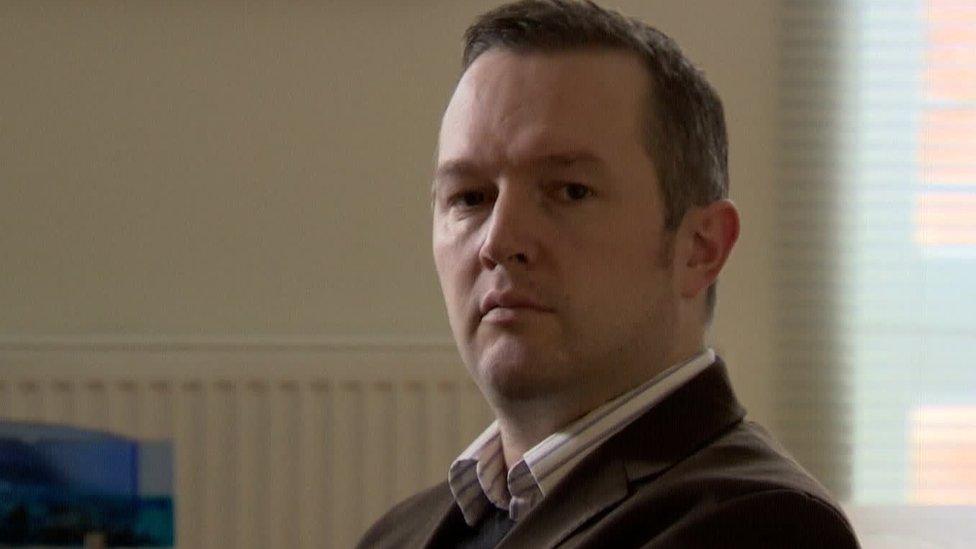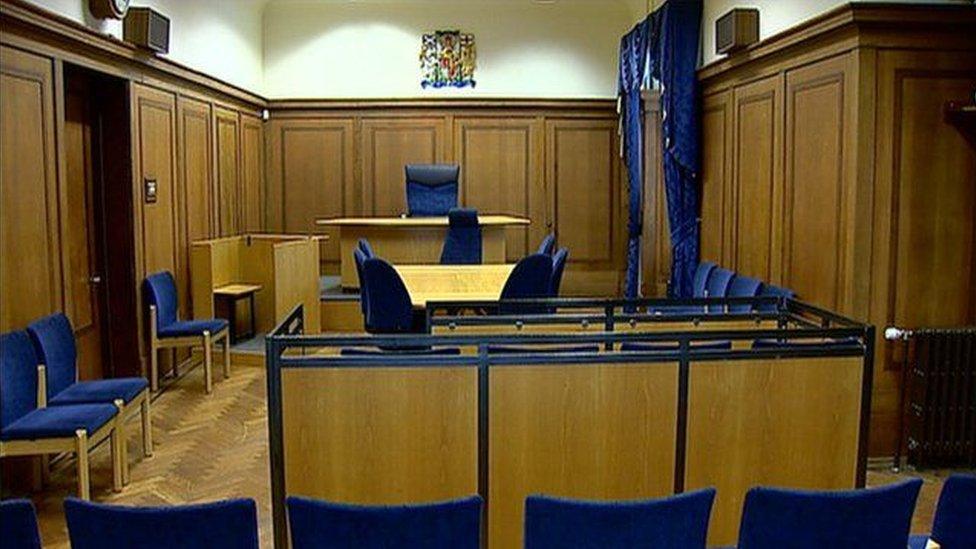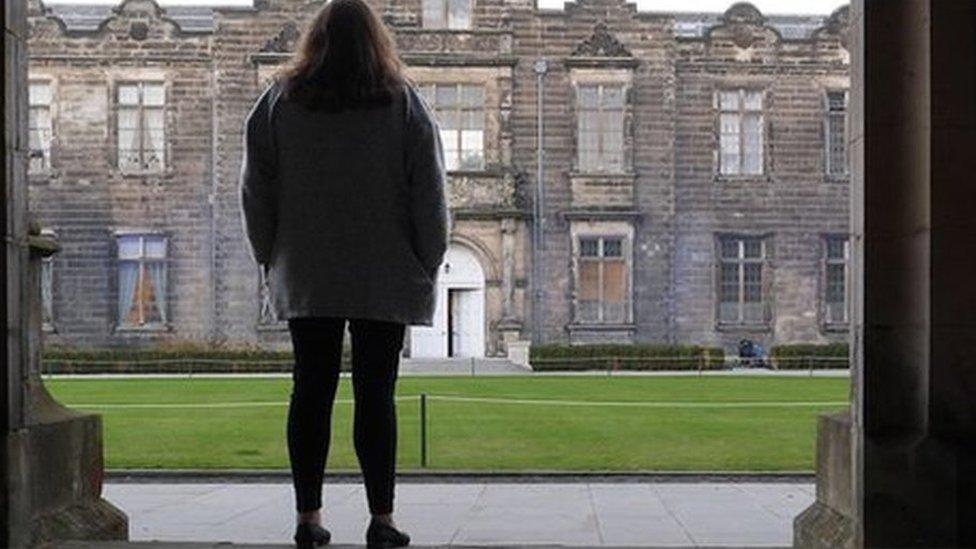Scrapping 'not proven' could edge jurors to guilty, says study
- Published

Lord Bonomy presides over mock jury in court research
Scrapping the controversial not proven verdict could edge more jurors towards a guilty verdict in finely balanced trials, a landmark study has found.
The two-year study also found reducing the size of juries in Scotland, from 15 to 12, could lead to more jurors switching to the majority view.
In a rare examination of the criminal trial system, researchers questioned 863 jurors during mock trials.
They wanted to find out what factors affected how jurors reached decisions.
Unlike most of the world's legal systems, Scotland has three possible verdicts in criminal cases - guilty, not guilty and not proven.
The legal implications of a not proven verdict are exactly the same as not guilty. In both cases the accused is acquitted and is innocent in the eyes of the law.
There has been sustained pressure for the not proven verdict to be dropped, particularly in sex crime cases where campaigners say it is clouded with ambiguity.
removing the not proven verdict might incline more jurors towards a guilty verdict in finely balanced trials
it also found inconsistent views on the meaning of not proven and how it differed from not guilty.
The findings suggest there may be truth in the popular belief that not proven indicates guilt but a failure of prosecutors fully to make the case.
Justice Secretary Humza Yousaf said he would now engage with legal professionals and the wider public to consider all of the findings, including whether to move to a two verdicts system.
"My mind is open and we will not pre-judge the outcome of those conversations," he said.
The research was undertaken on behalf of the Scottish government by Ipsos MORI Scotland and researchers from the Universities of Glasgow and Warwick.
Gordon Jackson QC, dean of the Faculty of Advocates, said: "This kind of research has never been undertaken before and it has produced some fascinating results which will need to be given careful consideration and very deep thought.
"All those involved in the work deserve to be commended."

What is the not proven verdict?

Three verdicts can be handed down in Scottish criminal cases: not guilty, not proven and guilty
Both not proven and not guilty are acquittal verdicts, which is seen by some as offering additional protection to the accused.
But critics argue that not proven is confusing for juries and the public, can stigmatise an accused person and fails to provide closure for victims.

Why does Scotland have three verdicts?

The not proven verdict is used for a very different purpose from that for which it was introduced
Prof James Chalmers, who was one of the lead researchers into the use of the not proven verdict, published a blog post two years ago with Prof Fiona Leverick looking at its history.
They believe that there was a common misconception that the not guilty verdict was a later addition to the proven and not proven outcomes.
The article says not only is the verdict of "not proven" not Scots law's original verdict of acquittal but today's "not proven" is used for a very different purpose from that for which it was introduced.
In more recent years, the general perception among the public has been that a "not proven" verdict suggests a sheriff or jury believes the accused is guilty, but does not have sufficient evidence to convict.
However, in law there is there no legal difference between a not guilty and not proven verdict.
In 2015, a review by Lord Bonomy said there was anecdotal evidence that jurors "mistakenly" thought that a not proven verdict left open the possibility of a retrial. "That is not the case," he said.

Why are rape victims calling for change?

Miss M is leading the campaign to have the not proven verdict scrapped
Campaigners say the not proven verdict is used disproportionately in rape cases.
Sandy Brindley, of Rape Crisis Scotland, said the verdict appeared to give an "easy out" for juries in rape trials.
She believes some juries see the not proven verdict as somehow "less painful" for those accusing someone of rape than a not guilty verdict.
Last year, Miss M - a rape victim who won a civil case against her attacker - called for Scotland to get rid of not proven.

What led to the Scottish jury study?

Prof James Chalmers was one of the lead researchers into the use of the not proven verdict
The Scottish jury research is a direct result of Lord Bonomy's Post-corroboration Safeguards Review in 2015.
He said that key components of the jury system - including the three verdicts, the simple majority required for conviction and the size of the jury - were inextricably linked.
Lord Bonomy recommended that jury research should be carried out to ensure that any changes to the system were based on fully informed evidence.
The academic research was carried out by Prof James Chalmers and Prof Fiona Leverick of the University of Glasgow law school as well as Prof Vanessa Munro from the University of Warwick.
Among the questions they asked was what jurors understood as the difference between not guilty and not proven and why they choose one over the other.
They also looked at the size of Scottish juries which, at 15 members, are large when compared to other systems around the world.
It also looked at whether juries should continue to convict on simple majority verdicts.
In England a majority verdict can be returned but the minimum majority is 10-2.
The Scottish jury research found that reducing jury size from 15 to 12 might lead to more individual jurors switching their position towards the majority view.
It also found asking juries to reach a unanimous or near unanimous verdict might tilt more jurors in favour of acquittal.

How often is not proven used?

The vast majority of criminal cases end, external in a guilty verdict.
Of the 34,584 crimes that came to court in 2017-18 just 1,944 resulted in acquittal.
About one in five (22.7%) of acquittal verdicts were not proven.
However, the conviction rate for rape and attempted rape is much lower than other crimes, with more than half of cases resulting in an acquittal.
In 2017-18 there were 88 not guilty verdicts in rape cases and 48 not proven (about 35% of acquittals and 19% of all cases).
Related topics
- Published24 September 2017

- Published21 April 2015

- Published13 November 2018
